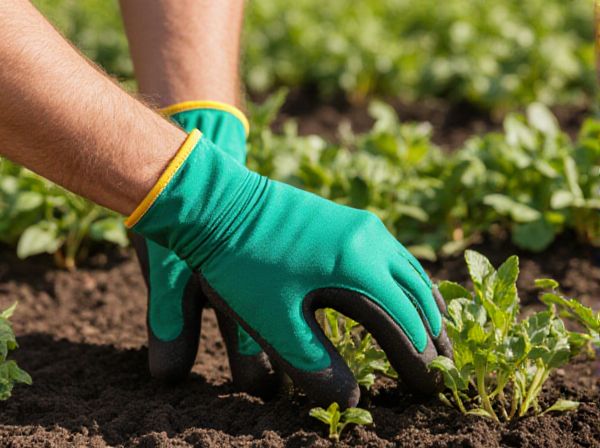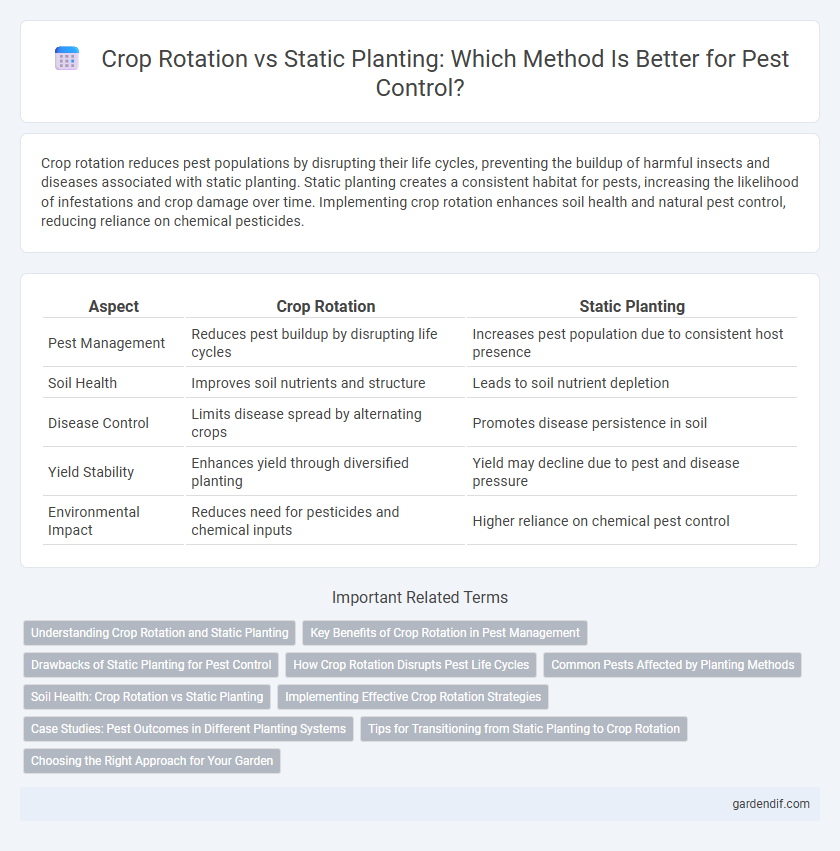
crop rotation vs static planting Illustration
Crop rotation reduces pest populations by disrupting their life cycles, preventing the buildup of harmful insects and diseases associated with static planting. Static planting creates a consistent habitat for pests, increasing the likelihood of infestations and crop damage over time. Implementing crop rotation enhances soil health and natural pest control, reducing reliance on chemical pesticides.
Table of Comparison
| Aspect | Crop Rotation | Static Planting |
|---|---|---|
| Pest Management | Reduces pest buildup by disrupting life cycles | Increases pest population due to consistent host presence |
| Soil Health | Improves soil nutrients and structure | Leads to soil nutrient depletion |
| Disease Control | Limits disease spread by alternating crops | Promotes disease persistence in soil |
| Yield Stability | Enhances yield through diversified planting | Yield may decline due to pest and disease pressure |
| Environmental Impact | Reduces need for pesticides and chemical inputs | Higher reliance on chemical pest control |
Understanding Crop Rotation and Static Planting
Crop rotation disrupts pest life cycles by alternating plant families seasonally, reducing pest buildup and soil-borne diseases more effectively than static planting, which involves growing the same crop repeatedly in one area. Static planting often leads to increased pest infestations and nutrient depletion, causing higher reliance on chemical pesticides and fertilizers. Implementing crop rotation enhances pest management and soil health, promoting sustainable agricultural practices.
Key Benefits of Crop Rotation in Pest Management
Crop rotation disrupts pest life cycles by alternating host plants, reducing pest populations and minimizing disease buildup in the soil. Diverse crop sequences improve soil health, enhancing plant resistance to pests and lowering reliance on chemical pesticides. This sustainable practice promotes balanced ecosystems, supporting beneficial insects and natural pest predators for long-term agricultural productivity.
Drawbacks of Static Planting for Pest Control
Static planting increases the risk of pest buildup and disease persistence as pests adapt to a constant host environment. Lack of crop diversity limits natural pest predators and disrupts soil health, leading to reduced pest resistance. Continuous monoculture can cause nutrient depletion, making crops more vulnerable to infestations and reducing overall yield stability.
How Crop Rotation Disrupts Pest Life Cycles
Crop rotation disrupts pest life cycles by altering the availability of host plants, reducing pest population buildup specific to one crop. Changing planting locations interrupts the reproductive cycles of soil-borne pests and pathogens, preventing their establishment and spread. This practice enhances soil health while naturally controlling pests, minimizing reliance on chemical pesticides.
Common Pests Affected by Planting Methods
Crop rotation disrupts the life cycles of common pests such as root-knot nematodes, aphids, and whiteflies by alternating host plants, reducing their population buildup in soil. Static planting allows pests like corn rootworms, wireworms, and cutworms to establish stable infestations due to consistent availability of preferred crops. Implementing diverse crop sequences minimizes pest pressure and lowers the reliance on chemical controls, promoting sustainable pest management.
Soil Health: Crop Rotation vs Static Planting
Crop rotation enhances soil health by disrupting pest cycles and promoting nutrient balance, reducing the buildup of pathogens and pests associated with static planting. Diverse crop sequences improve soil structure and increase microbial diversity, which supports natural pest control and nutrient availability. Static planting depletes soil nutrients, leading to increased vulnerability to pest infestations and reduced long-term soil fertility.
Implementing Effective Crop Rotation Strategies
Implementing effective crop rotation strategies disrupts pest life cycles by alternating crop families, reducing the buildup of host-specific pests and diseases. Rotating crops like legumes, cereals, and root vegetables enhances soil health and lowers pest pressure compared to static planting, which allows pests to establish and proliferate. Optimizing rotation sequences based on pest biology and soil conditions maximizes pest suppression and improves overall crop yield.
Case Studies: Pest Outcomes in Different Planting Systems
Case studies reveal that crop rotation significantly reduces pest populations compared to static planting systems by disrupting pest life cycles and decreasing host availability. Research in maize and soybean fields demonstrates a 40-60% decline in rootworm and aphid infestations under rotational schemes. Long-term trials in Europe corroborate that diversified cropping systems limit pest resistance development and improve natural predator presence, enhancing overall pest management.
Tips for Transitioning from Static Planting to Crop Rotation
Gradually introduce diverse crops to disrupt pest life cycles and improve soil health when transitioning from static planting to crop rotation. Start with simple rotation plans that cycle between two or three crop families, reducing pest buildup and enhancing nutrient balance. Monitor pest populations closely and adjust crop sequences based on observed pest pressures and soil conditions for optimal results.
Choosing the Right Approach for Your Garden
Crop rotation disrupts pest life cycles by alternating plant families, reducing the buildup of species-specific pests and diseases in the soil. Static planting increases vulnerability to cumulative pest infestations, leading to higher pesticide use and potential yield loss. Opting for crop rotation enhances soil health, pest management, and sustainable garden productivity over time.
crop rotation vs static planting Infographic

 gardendif.com
gardendif.com